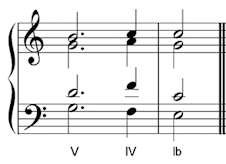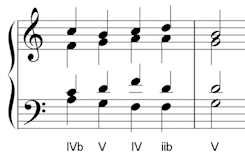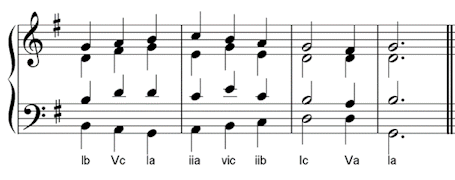A passing chord is a decorative chord which does not affect the overall harmonic structure of the music – it is like a passing note[1], but written as a whole chord.
Passing chords can be inserted between two chords that we would normally expect to find right next to each other, for example between chords V and I. Although V does not normally move to IV, the chord IV in this example does not count as part of the progression, because V still moves to I on the strong beats of the bar. IV is a passing chord and the main progression is V-Ib.

Sometimes a passing chord sits between two different inversions of the same chord. In this example, chord V is the passing chord, sitting between two different inversions of chord IV. Essentially, this progression is IV-iib-V.

Usually, the passing chord is not accented or otherwise emphasised, and the bass part will move by step for three notes. The passing chord harmonises the middle note.
If you see a progression where the chord or inversion looks like it is out of place, consider whether it is in fact a passing chord, and therefore allowable.
A common type of passing chord is the “passing 6/4”.
Passing 6/4
The passing 6-4 is another progression where you can use a second inversion chord. In a passing 6-4 the bass moves by step for three notes, and the 6/4 chord is the middle one.

In a passing 6/4, the second inversion chord normally falls on a weak beat of the bar.
Look at the passing 6-4 above and notice that:
- the bass line moves by step: C – D – E,
- the second inversion chord (Vc) falls on a weak (middle) beat,
- the other parts move by the smallest possible steps.
As you can see, passing 6/4s are very unlike cadential 6/4s, although both of them use second inversion chords. Here’s a summary of the differences:
| Passing 6/4 | Cadential 6/4 |
| Falls on a weak beat | Falls on a strong beat |
| Bass moves by step | Bass note is repeated or held |
| (Almost) any chord | Only Ic |
If you are choosing chords to harmonise a melody, look for places where the melody moves up or down by three notes, by step. Put the same notes in the bass, but in reverse order, and use a second inversion chord for the middle chord.
The following melody will work with three 6/4 chords – can you spot where they will work?

The first two bars will work with passing 6/4s, and a cadential 6/4 will work at the end.
For the passing 6/4s, the bass will move by step in contrary motion with the soprano.
For the cadential 6/4, the bass note will be repeated.

Here are the full chords:

[1] See “Decoration” for more about passing notes.